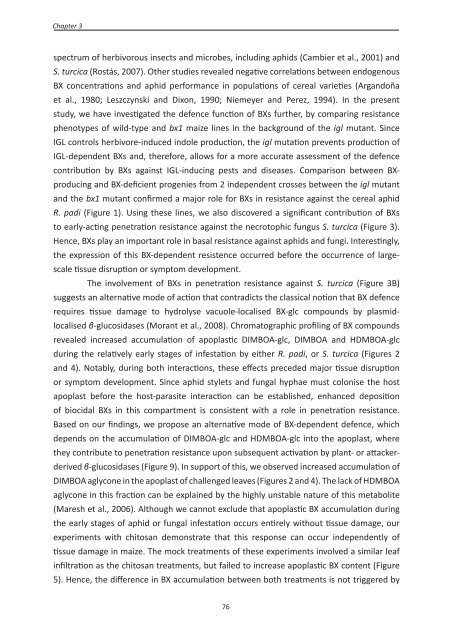Plant basal resistance - Universiteit Utrecht
Plant basal resistance - Universiteit Utrecht
Plant basal resistance - Universiteit Utrecht
You also want an ePaper? Increase the reach of your titles
YUMPU automatically turns print PDFs into web optimized ePapers that Google loves.
Chapter 3<br />
spectrum of herbivorous insects and microbes, including aphids (Cambier et al., 2001) and<br />
S. turcica (Rostás, 2007). Other studies revealed negative correlations between endogenous<br />
BX concentrations and aphid performance in populations of cereal varieties (Argandoña<br />
et al., 1980; Leszczynski and Dixon, 1990; Niemeyer and Perez, 1994). In the present<br />
study, we have investigated the defence function of BXs further, by comparing <strong>resistance</strong><br />
phenotypes of wild-type and bx1 maize lines in the background of the igl mutant. Since<br />
IGL controls herbivore-induced indole production, the igl mutation prevents production of<br />
IGL-dependent BXs and, therefore, allows for a more accurate assessment of the defence<br />
contribution by BXs against IGL-inducing pests and diseases. Comparison between BX-<br />
producing and BX-deficient progenies from 2 independent crosses between the igl mutant<br />
and the bx1 mutant confirmed a major role for BXs in <strong>resistance</strong> against the cereal aphid<br />
R. padi (Figure 1). Using these lines, we also discovered a significant contribution of BXs<br />
to early-acting penetration <strong>resistance</strong> against the necrotophic fungus S. turcica (Figure 3).<br />
Hence, BXs play an important role in <strong>basal</strong> <strong>resistance</strong> against aphids and fungi. Interestingly,<br />
the expression of this BX-dependent resistence occurred before the occurrence of large-<br />
scale tissue disruption or symptom development.<br />
The involvement of BXs in penetration <strong>resistance</strong> against S. turcica (Figure 3B)<br />
suggests an alternative mode of action that contradicts the classical notion that BX defence<br />
requires tissue damage to hydrolyse vacuole-localised BX-glc compounds by plasmid-<br />
localised β-glucosidases (Morant et al., 2008). Chromatographic profiling of BX compounds<br />
revealed increased accumulation of apoplastic DIMBOA-glc, DIMBOA and HDMBOA-glc<br />
during the relatively early stages of infestation by either R. padi, or S. turcica (Figures 2<br />
and 4). Notably, during both interactions, these effects preceded major tissue disruption<br />
or symptom development. Since aphid stylets and fungal hyphae must colonise the host<br />
apoplast before the host-parasite interaction can be established, enhanced deposition<br />
of biocidal BXs in this compartment is consistent with a role in penetration <strong>resistance</strong>.<br />
Based on our findings, we propose an alternative mode of BX-dependent defence, which<br />
depends on the accumulation of DIMBOA-glc and HDMBOA-glc into the apoplast, where<br />
they contribute to penetration <strong>resistance</strong> upon subsequent activation by plant- or attacker-<br />
derived β-glucosidases (Figure 9). In support of this, we observed increased accumulation of<br />
DIMBOA aglycone in the apoplast of challenged leaves (Figures 2 and 4). The lack of HDMBOA<br />
aglycone in this fraction can be explained by the highly unstable nature of this metabolite<br />
(Maresh et al., 2006). Although we cannot exclude that apoplastic BX accumulation during<br />
the early stages of aphid or fungal infestation occurs entirely without tissue damage, our<br />
experiments with chitosan demonstrate that this response can occur independently of<br />
tissue damage in maize. The mock treatments of these experiments involved a similar leaf<br />
infiltration as the chitosan treatments, but failed to increase apoplastic BX content (Figure<br />
5). Hence, the difference in BX accumulation between both treatments is not triggered by<br />
76

















